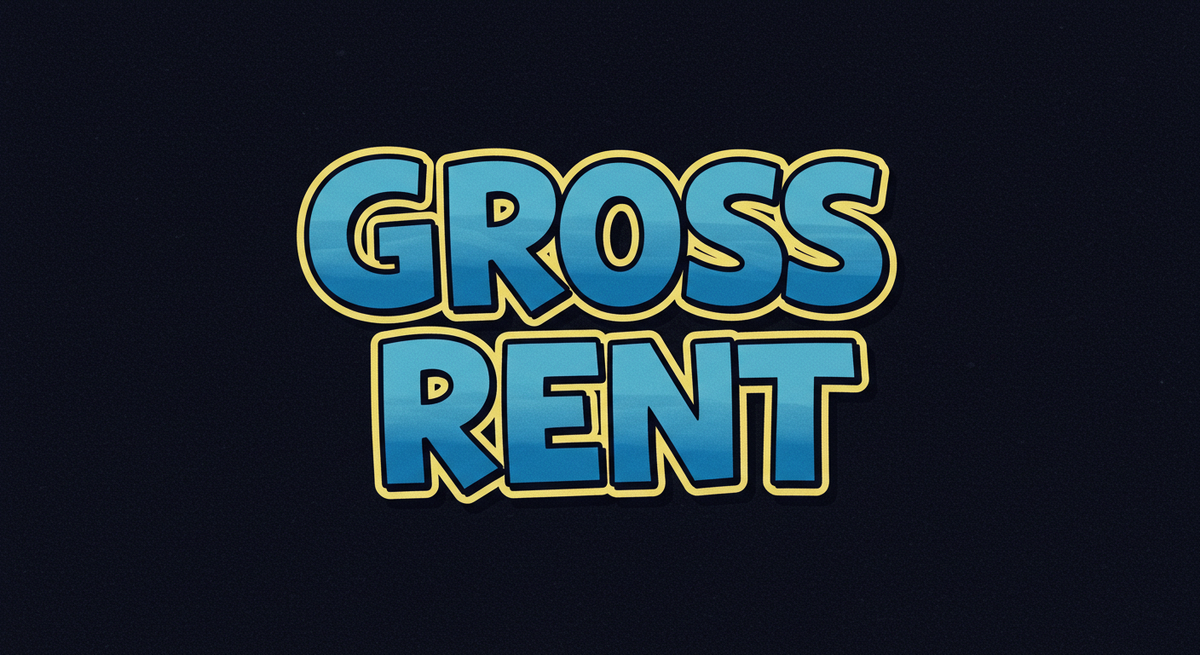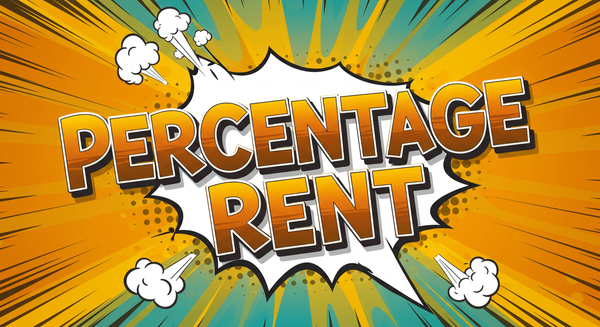Gross Rent in Property Management: The Complete Guide
The U.S. Census Bureau includes everything from electricity bills to wood heating costs in gross rent calculations, making it far more complex than most property managers realize

Property managers deal with countless financial terms, but few are as fundamental—or misunderstood—as gross rent. Here's a fascinating fact: The U.S. Census Bureau includes everything from electricity bills to wood heating costs in gross rent calculations, making it far more complex than most property managers realize.
Gross rent represents the total amount tenants pay for housing, including base rent plus utilities and other essential services. Unlike base rent, which covers only the property itself, gross rent provides a comprehensive view of actual tenant housing costs. This distinction matters enormously for property managers navigating everything from rental income analysis to federal housing compliance.
In this article, you'll learn what gross rent means in practice, how it impacts your property valuation metrics, essential legal considerations, and proven strategies for optimizing gross rent structures across your portfolio.
What Is Gross Rent? Understanding Rental Income Analysis
Gross rent is the total monthly amount tenants pay for rental housing, encompassing base rent plus utilities, maintenance fees, and other housing-related services included in the lease agreement.
This comprehensive figure represents the true cost of occupancy from a tenant's perspective and forms the foundation for rental income analysis.
The U.S. Census Bureau defines gross rent as "the contract rent plus the estimated average monthly cost of utilities (electricity, gas, and water and sewer) and fuels (oil, coal, kerosene, wood, etc.) if these are paid by the renter". This definition establishes gross rent as the complete housing cost burden, eliminating confusion about what tenants actually pay monthly.
How Does Gross Rent Compare to Other Rental Income Terms?
Gross rent differs significantly from related property management terms:
- Base rent: The fixed amount before any additional charges
- Net rent: Base rent where tenants pay utilities separately
- Net effective rent: Gross rent adjusted for concessions spread over the lease term
- Modified gross lease: Hybrid gross lease structure where some but not all expenses are included
- Effective gross rental income: The difference between gross annual rent and vacancy/credit loss
In commercial real estate, gross rent typically means the tenant pays a set amount while the property owner covers property maintenance, taxes, and most operational expenses for the commercial property. This contrasts with triple net lease (NNN lease) arrangements where tenants pay base rent plus their proportional share of property taxes, insurance, and maintenance costs.
Understanding gross rent multiplier calculations helps property managers evaluate investment performance by comparing gross annual rental income to property price. Need help? Use our free Gross Rent Multiplier Calculator.
Gross Rent vs Net Rent: What's the Difference?
Understanding the two main rental payment structures for property managers
- Base rent amount
- Electricity costs
- Gas/heating bills
- Water & sewer
- Property maintenance
- Common area utilities
- Base rent amount only
- Electricity bills
- Gas/heating costs
- Water & sewer
- Internet/cable
- Renter's insurance
- • Predictable tenant costs
- • Simplified billing process
- • Higher tenant satisfaction
- • Easier budget planning
- • Reduced administrative work
- • Lower landlord utility risk
- • Tenants control usage costs
- • Easier to adjust for markets
- • Promotes energy conservation
- • Transparent cost structure
Impact & Applications
Operational Impact
Gross rent structures fundamentally shape your property's financial performance and operational complexity. Properties using gross rent models can command premium pricing due to the convenience factor, but landlords assume responsibility for utility cost fluctuations and maintenance expenses.
Inaccurate gross rent calculations can lead to significant compliance violations and revenue shortfalls. Federal housing programs like Section 8 require precise gross rent determinations for payment standard calculations. Failure to comply with HUD requirements can result in consequences "ranging from successfully submitting explanation and/or support for correction of the violation to HUD to clear the finding to submission to ongoing HUD oversight and monitoring, to referral of the owner and manager to HUD's Departmental Enforcement Center".
The gross rent multiplier serves as a critical valuation tool for real estate investing. Industry data shows that good gross rent multiplier ratios typically fall between 4-7 for residential properties, with ratios above 10 often indicating overpriced properties or below-market rents. This metric helps property managers evaluate acquisition opportunities and optimize rental pricing across their portfolio.
Gross rent structures also impact tenant retention and satisfaction. Properties offering predictable gross rent payments typically experience improved tenant relationships compared to properties with variable utility billing. Tenants prefer the budgeting certainty that gross rent provides, even when paying slightly higher overall costs.
Real-World Application
Example: Converting a 24-Unit Complex from Net to Gross Rent
- Challenge: A property management company in Austin inherited a 24-unit complex where tenants paid base rent plus individual utility bills, creating collection issues and high administrative costs.
- Solution: They implemented a gross rent structure by analyzing 12 months of utility data, calculating average monthly costs per unit type, and adding these amounts to base rent. One-bedroom units increased from $1,200 base rent to $1,380 gross rent, while two-bedroom units rose from $1,500 to $1,720.
- Outcome: Administrative burden decreased significantly through elimination of utility billing management, tenant satisfaction improved due to predictable monthly costs, and vacancy rates declined within six months.
- Takeaway: Gross rent structures can reduce operational complexity while improving tenant experience, even when resulting in higher monthly payments.
The property management team also discovered that gross rent simplified their cap rate calculations and made the property more attractive to potential buyers seeking predictable cash flow.
Legal & Compliance Essentials
Federal housing regulations require specific gross rent calculations for properties participating in government assistance programs. HUD mandates that gross rent include base rent plus reasonable utility allowances, with detailed documentation requirements for compliance verification.
Key Legal Considerations:
- Fair Market Rent (FMR) Compliance: HUD uses gross rent calculations to establish FMR levels that affect Housing Choice Voucher payment standards
- Rent Reasonableness Requirements: Properties accepting Section 8 vouchers must demonstrate gross rent reasonableness through comparable market analysis
- Income Averaging Tests: Low-income housing tax credit properties must maintain specific gross rent limitations based on Area Median Income
- Documentation Standards: Maintain comprehensive records of utility allowances, actual costs, and market comparisons for audit purposes
Critical Pitfalls to Avoid:
- Never assume Fair Market Rent automatically establishes rent reasonableness—comprehensive market analysis remains required
- Don't neglect annual utility allowance reviews—outdated calculations can trigger compliance violations
- Avoid mixing gross and net rent structures within the same property without proper lease documentation
HUD's suspension and debarment procedures apply to "serious HUD program violations, which include bribery, false statements, embezzlement, theft and forgery." While gross rent calculation errors typically don't rise to this level, persistent compliance failures can result in program exclusion.
State regulations vary significantly regarding gross rent definitions and tenant protection requirements. Texas eviction processes require specific notice procedures when gross rent includes utility costs, while Michigan provides homestead property tax credits based on gross rent calculations.
Commercial lease agreements must clearly specify which expenses are included in gross rent to avoid disputes. Ambiguous lease language regarding maintenance costs or property expenses can result in costly legal battles and tenant relations problems.
Best Practices for Gross Rent
1. Conduct Annual Utility Cost Analysis
Analyze 12 months of actual utility data before setting gross rent levels. Review electricity, gas, water, and sewer costs across all unit types, accounting for seasonal variations and conservation efforts. Use this data to establish realistic utility allowances that cover actual costs without excessive padding.
Implement quarterly utility cost reviews to identify trends and adjust future gross rent calculations accordingly.
2. Implement Market-Based Gross Rent Positioning
Research comparable properties offering similar gross rent structures within your market area. Collect gross rent data from at least three comparable unassisted units, analyzing location, amenities, and condition factors. This analysis ensures competitive positioning while maintaining compliance with federal rent reasonableness requirements.
Use automated market analysis tools to streamline this process and maintain current pricing strategies.
3. Structure Clear Lease Agreement Language
Define gross rent components explicitly in all lease agreements to prevent tenant disputes. Specify which utilities, services, and maintenance items are included versus excluded from gross rent payments. Include utility conservation clauses that protect against excessive usage while maintaining tenant comfort.
Consider implementing lease co-applicant agreements that clearly outline gross rent responsibilities among multiple tenants.
4. Leverage Technology for Gross Rent Management
Integrate property management software that automates gross rent calculations and tracks utility cost trends. Modern platforms can analyze historical utility data, predict seasonal variations, and suggest optimal gross rent adjustments based on market conditions and operational costs.
Implement automated reporting systems that track gross rent collection rates and identify properties requiring pricing adjustments.
Frequently Asked Questions About Gross Rent
What's the difference between gross rent and net rent in property management?
Gross rent includes utilities and services in one monthly payment, while net rent requires tenants to pay utilities separately. Gross rent provides predictable costs for tenants but transfers utility risk to landlords. Net rent offers potentially lower base payments but creates variable monthly costs for tenants.
Property managers should choose based on their risk tolerance and tenant preferences. Gross rental yield helps real estate investors "assess if the potential return on a property investment meets their minimum return threshold."
How do you calculate gross rent multiplier for investment analysis?
The gross rent multiplier formula divides property price by gross annual rental income. For investment analysis, multiply monthly gross rent by 12 to determine gross annual rental income, then apply the gross rent multiplier by dividing property price by annual gross rental income.
Ratios between 4-7 typically indicate appropriately priced properties, while "a lower GRM may indicate a potentially more profitable property."
Can gross rent amounts change during an active lease term?
Gross rent typically remains fixed during the initial lease term unless specifically allowed in the lease agreement. However, landlords can adjust gross rent at lease renewal based on utility cost changes, market conditions, and property improvements.
Month-to-month tenancies may allow gross rent adjustments with proper notice, usually 30 days depending on state regulations. Property managers must document any utility cost increases to justify gross rent adjustments.
How does gross rent affect property valuation metrics?
Gross rent directly impacts several key investment metrics including cap rate calculations and cash flow analysis. Net operating income (NOI) is calculated as "the Effective Gross Income minus total Operating Expenses", where effective gross income starts with gross rental income.
Property managers use gross rent data for rental yield calculations, where "gross rental yield is calculated by dividing the annual rental income by the property's purchase price, then multiplying by 100 to get the percentage."
What's included in gross rent versus effective gross rental income?
Gross rent represents the total tenant payment, while effective gross rental income accounts for vacancy losses. Effective gross rental income is "calculated as the difference between gross annual rent and vacancy/credit loss" and helps property managers forecast realistic cash flow expectations.
This distinction matters for accurate rental property income statements, where gross income includes "all rental payments received, including income from renting out individual rooms or multiple units within a property."
Gross Rent Multiplier (GRM) Investment Guide
Understanding what makes a good GRM for rental property investments
- Lower GRM values indicate faster payback periods and better returns
- GRM between 4-7 is considered ideal for most residential properties
- Always compare GRM to similar properties in the same market area
- GRM doesn't account for expenses - use alongside cap rate analysis
- High-growth markets may justify slightly higher GRM ratios
State-by-State Variations in Gross Rent Regulations
Understanding how gross rent regulations vary across states is crucial for property managers operating in multiple jurisdictions.
Texas: Requires rent reasonableness analyses based on gross rent calculations, mandating that proposed unit gross rents remain within 5% of average gross rents for comparable unassisted rental units. Texas also has specific eviction notice requirements when gross rent includes utilities.
Michigan: Provides specific gross rent definitions for homestead property tax credit calculations, including provisions for departmental rent adjustments when landlord-tenant relationships lack arms-length dealing. This protects against excessive rent charges while maintaining market-based pricing.
California: Property management fees often calculated as percentage of gross rents collected, with rates varying from 3% on large structures to 20% on individual houses. Resort areas may charge up to 50% of gross rent as management fees.
Federal Programs: All states must comply with HUD's gross rent requirements for federally assisted housing, but local Public Housing Agencies have discretion in setting payment standards and utility allowances within federal guidelines.
Property managers should consult local housing authorities and state real estate commissions for specific gross rent requirements in their operating areas.
Technology Integration in Gross Rent Management
Modern property management software has revolutionized gross rent administration and compliance tracking. Leading platforms offer comprehensive solutions for accurate gross rent calculations and market analysis.
How Does Software Improve Gross Rent Accuracy?
Automated Utility Tracking: Software can integrate with utility companies to track actual consumption data, eliminating manual calculation errors and improving gross rent accuracy. This real-time data helps property managers adjust gross rent calculations based on actual utility costs rather than estimates.
Market Analysis Tools: Platforms like RentSpree and AppFolio provide automated market rent surveys, helping property managers maintain competitive gross rent positioning while ensuring compliance with federal rent reasonableness requirements.
Compliance Monitoring: Software can track HUD reporting requirements, generate necessary documentation for audits, and alert managers to upcoming utility allowance review deadlines.
What Are the Best Free and Affordable Property Management Software Options?
Property managers can access gross rent management tools through various pricing tiers:
Free and Affordable Options:
- Buildium: Offers gross rent calculation tools in their basic plans starting at $50/month
- DoorLoop: Provides utility tracking features at affordable rates for small to medium portfolios
- Rentec Direct: Includes basic gross rent management in affordable plans starting at $45/month
- Free/Freemium Options: Innago, Avail, LandlordStudio
Enterprise Solutions:
- AppFolio: Advanced gross rent analytics and market positioning tools
- RentManager: Comprehensive utility allowance tracking and HUD compliance features
- Yardi: Enterprise-level gross rent management with automated compliance reporting
Property managers should evaluate software based on their portfolio size, compliance needs, and integration requirements with existing accounting systems.
Fascinating Facts About Gross Rent
The concept of gross rent has some surprising historical and practical elements:
Census Bureau Precision: The U.S. Census Bureau includes "oil, coal, kerosene, wood, etc." in gross rent calculations, reflecting housing realities from when these were common heating sources. This definition hasn't changed since the 1960s despite dramatic shifts in utility usage.
Industry Scale: IREM data shows multifamily communities collected total gross rents of $20,420.92 per unit in 2023, representing a 5% increase from the previous year. This means the gross rent market represents hundreds of billions in annual transactions.
Stability Factor: Despite rental cost increases of 3.8% annually in 2023, the share of renter income spent on gross rent remained stable at 31.0%, indicating that household incomes kept pace with rental inflation.
Investment Metric Origins: The gross rent multiplier concept originated in the 1920s as a "back-of-envelope" calculation for real estate investors, long before modern financial analysis tools existed.
Evolution of Gross Rent Definitions
How gross rent concepts have developed in property management over the decades
Conclusion & Resources
Gross rent management represents a cornerstone of successful property operations that impacts everything from tenant satisfaction to investment returns.
Understanding gross rent calculations protects you from compliance violations, optimizes cash flow, and creates predictable tenant experiences. Properties with well-structured gross rent models typically achieve stronger tenant retention and simplified financial management.
Key takeaways for property managers:
- Accurate utility estimation prevents revenue losses - Analyze 12+ months of actual costs before setting gross rent levels
- Market positioning matters - Research comparable gross rent structures to maintain competitive advantage
- Documentation ensures compliance - Maintain detailed records for federal housing program requirements
Rental Property Cash Flow Waterfall Analysis
From gross potential rent to net operating income: understanding the cash flow journey
- Monthly Base Rent: $3,500
- Utility Allowance: $300
- Other Income: $200
- Total Monthly: $4,000
- Property Management: $400
- Maintenance & Repairs: $500
- Property Taxes: $600
- Insurance: $200
- Utilities: $300
- Total Monthly: $2,000
- Effective Gross Income: $4,500
- Operating Expenses: ($2,000)
- Operating Expense Ratio: 44.4%
- Net Operating Income: $2,500
Ready to optimize your property management approach? Explore our understanding cap rates guide and discover how build-to-rent communities are revolutionizing rental strategies. Our complete resource library provides proven frameworks for maximizing your portfolio performance.
Legal Disclaimer: The information on this website is sourced from publicly available materials and is provided for general informational purposes only. It is not intended as legal, financial, or accounting advice. LandlordDoc.com makes no guarantees about the accuracy or completeness of the information and assumes no liability for any errors, omissions, or outcomes related to its use.





